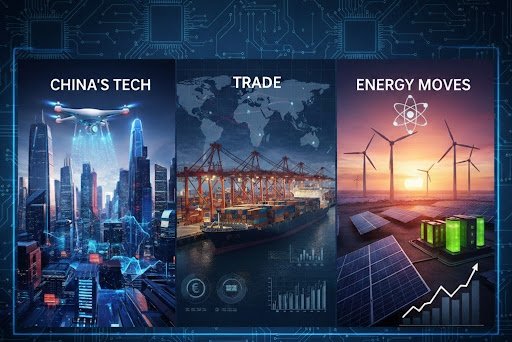Tech
Fastest Way to Send Large Files in 2025: The Ultimate Guide

In today’s fast-paced digital world, speed is everything—especially when it comes to transferring large files. Whether you’re a freelancer sending high-res design files, a video editor sharing raw footage, or a business team exchanging critical documents, you need fast, secure, and reliable ways to send big files without delays.
But let’s be real—email attachments just don’t cut it anymore.
So what’s the fastest way to send large files in 2025?
This article explores the top methods, tools, and tips to send big files quickly, whether you’re working remotely, collaborating with a global team, or just trying to beat a tight deadline.
Why Traditional Methods Fail for Large File Transfers
Before we dive into the fastest methods, let’s talk about what not to do.
- Email Attachments: Most email providers cap attachments at 25MB. That’s not enough for most videos, high-resolution images, or project files.
- USB Drives: Physical delivery is not only slow but also risky in case of damage or loss.
- Old FTP Servers: These are clunky, slow, and often require technical knowledge to set up properly.
1. WeTransfer Pro — Speedy and User-Friendly
WeTransfer is a household name in file sharing. With WeTransfer Pro, you can send up to 200 GB in one go with blazing fast speeds. No account needed for recipients, which makes the process smoother for clients and collaborators.
Key Features:
- Send up to 200 GB per transfer
- Password protection and expiration dates
- Custom branding and personalized emails
- Cloud-based, no need to install software
2. MASV – Designed for Massive Files
MASV is built for professionals who deal with huge file sizes, such as filmmakers, ad agencies, and post-production studios. It leverages cloud infrastructure to offer lightning-fast transfer speeds.
What Makes It Unique:
- No file size limits
- Pay-as-you-go pricing (great for occasional use)
- Integrates with Adobe Premiere, Frame.io, and more
- Secure, encrypted transfers
3. Google Drive + ZIP Compression
If you’re already a Google user, take advantage of Google Drive’s generous storage limits. While the upload may take longer for very large files, compressing them into a .zip or .rar file can speed things up.
Advantages:
- 15 GB free storage (more with Google One)
- Easy sharing permissions
- Direct collaboration with Docs, Sheets, etc.
- Virus scanning built-in
4. Filemail
Filemail is another strong contender when it comes to fast file transfer. It offers ultra-fast UDP transfer protocols, which can be up to 200 times faster than traditional HTTP uploads.
Why it’s Great:
- Send files up to 5 GB without getting registration.
- Unlimited size with paid plans
- Track downloads, delivery status
- Desktop app available for even faster speeds
5. Peer-to-Peer (P2P) Tools like Raysync
Sometimes the fastest way to send large files is to skip the cloud altogether. Raysync uses peer-to-peer technology (similar to BitTorrent) to transfer files directly from one device to another.
Top Benefits:
- No file size limits
- Data doesn’t pass through a server
- End-to-end encrypted
- Ideal for syncing large folders or backup files
6. Smash – Fast, No Size Limit
It’s uncommon that Smash allows you to send files with no size limitation. The free version has some speed throttling for very large files, but premium users get full bandwidth and customization options.
Why it’s Worth Trying:
- Unlimited file size (free + paid)
- No registration needed
- Files stored for up to 14 days (longer on Pro)
- GDPR-compliant for EU businesses
Tips to Speed up Large File Transfers
No matter which service you choose, here are some actionable tips to make file transfers faster and smoother:
- Compress before Sending: Use .zip or .rar formats to shrink files.
- Use Wired Internet: Ethernet connections are more stable and faster than Wi-Fi.
- Upload During Off-Peak Hours: Late-night or early-morning uploads can be faster due to lower network congestion.
- Split Files into Parts: Break files into chunks if your service supports it.
- Check Firewall/Antivirus Settings: Some security software can slow down upload speeds.
What about Security?
Speed is great—but security matters just as much. Always choose services that offer:
- End-to-end encryption
- Password protection
- Expiration dates for shared links
- Two-factor authentication (2FA)
Final Thoughts
The fastest way to send large files depends on your exact needs:
| Need | Best option |
| Simple and Fast | Wetransfer Pro |
| Massive Files | MASV or Filemail |
| Free + Convenient | Google Drive + Zip |
| No Size Limit | Smash |
| Peer-to-Peer & Private | Resilio Sync |
Quick Recap:
- Use WeTransfer Pro for fast, professional transfers.
- Choose MASV or Filemail for sending huge media files.
- Compress files before uploading for faster speeds.
- Use wired internet for reliable performance.
● Prioritize tools with strong encryption and password protection.
Tech
Why Creators, Influencers, and Brands Are Turning to FaceSwapAI in 2025

As digital creativity continues to evolve, Artificial Intelligence (AI) has become the ultimate game-changer for creators, influencers, and brands. One of the most exciting innovations in this space is AI-powered face swapping — a technology that blends fun, creativity, and storytelling like never before. In 2025, more and more people are turning to FaceSwapAI, a cutting-edge platform that redefines what’s possible in visual content creation.
With powerful deep learning algorithms and an easy-to-use interface, FaceSwapAI is transforming how we create, market, and entertain online. Whether you’re an influencer making viral videos, a brand producing creative campaigns, or a filmmaker experimenting with effects, remaker ai face swap is the perfect tool to bring your ideas to life — instantly, intelligently, and with stunning realism.
The Rise of AI-Powered Creativity
AI tools are reshaping how digital content is made. In the past, creating visual effects like face swaps required technical skills, expensive software, and countless editing hours. Now, platforms like FaceSwapAI have made it possible for anyone — from casual users to professionals — to achieve cinematic-quality results in seconds.
Using advanced AI models, FaceSwapAI analyzes facial structures, lighting, and expressions to produce realistic swaps that blend seamlessly into photos or videos. The results are so natural that they can be used for everything from funny memes to professional marketing campaigns.
This accessibility has sparked a new wave of creativity online, empowering people to experiment, entertain, and express themselves in bold new ways.
Why Creators and Influencers Love FaceSwapAI
In 2025’s social media landscape, standing out means being creative, fast, and authentic. FaceSwapAI helps influencers and content creators do just that.
- Viral Content Made Easy: Creators can swap faces in trending videos, recreate iconic movie moments, or make hilarious memes — all in seconds.
- Authentic Engagement: Personalized and funny content grabs attention, drives engagement, and increases follower growth.
- No Editing Skills Needed: The platform’s intuitive design makes it easy for anyone to use, even without experience.
- High-Quality Results: FaceSwapAI ensures that every edit looks natural, professional, and ready to post.
Whether you’re an influencer on TikTok, YouTube, or Instagram, FaceSwapAI helps you produce eye-catching content that connects with audiences — quickly and effortlessly.
How Brands Are Using FaceSwapAI
For businesses, creativity is key to capturing attention in the crowded digital marketplace. Brands are using FaceSwapAI to create innovative, memorable campaigns that stand out from the competition.
- Personalized Ads: Brands can swap faces in promotional videos to tailor content to different audiences.
- Interactive Campaigns: Marketers can engage consumers by allowing them to “put themselves” in an ad — a fun and shareable experience.
- Cost-Effective Visuals: Instead of expensive reshoots or complex animations, FaceSwapAI delivers professional-quality visuals in minutes.
This new wave of AI-powered creativity is helping brands connect with audiences on a deeper level, making marketing more engaging, efficient, and relatable.
A Safer and Smarter Approach to AI
While face-swapping technology is exciting, it also comes with ethical responsibilities. FaceSwapAI is designed with safety and integrity in mind. The platform prioritizes data security, privacy, and the responsible use of AI technology.
By promoting creativity while discouraging misuse, FaceSwapAI empowers users to have fun and innovate without compromising ethics. This commitment to safety makes it a trusted platform for both individuals and organizations.
Why FaceSwapAI Stands Out in 2025
FaceSwapAI isn’t just another AI editing app — it’s the future of digital creativity. Here’s why it continues to dominate in 2025:
- AI Precision: Advanced deep learning ensures flawless, lifelike face swaps.
- Speed and Convenience: Create content in seconds — perfect for fast-paced social media trends.
- Cross-Platform Use: Ideal for photos, videos, ads, and entertainment.
- Accessible for All: No downloads or special skills required — everything happens online.
- Innovative and Evolving: Constant updates keep FaceSwapAI ahead of the curve in AI innovation.
Whether for personal fun, social media growth, or large-scale branding, FaceSwapAI offers a creative edge that users can’t find anywhere else.
The Future of AI Creativity
Looking ahead, AI-powered creativity will continue to redefine how we communicate and entertain. Tools like FaceSwapAI are leading this transformation, enabling users to craft dynamic visuals that feel fresh, human, and engaging.
As more creators, influencers, and brands embrace the potential of AI, the line between technology and artistry will continue to blur — creating a new era of digital storytelling.
Conclusion
FaceSwapAI has become a must-have tool for anyone looking to stand out in 2025. Its combination of smart technology, ease of use, and ethical design makes it a favorite among creators, influencers, and brands alike. From viral social media videos to high-end marketing campaigns, it’s redefining what’s possible in AI-powered editing.
Tech
Understanding the Importance of Personalized Email Hosting for Startups

Running a startup is hard work. From product development, acquiring customers, funding rounds, and a million other things on your to-do list, there’s always something that needs your attention. But here’s one thing that’s almost always neglected, yet is one of the simplest, and often makes the biggest difference…
Your email address.
Look, I know it’s not a great topic, but hear me out. Using a professional email hosting solution with a personalized email address can be the difference between getting that big client and getting ignored.
Key Takeaways
- Why Professional Email Matters For Startups
- Email Hosting vs Free Email Providers
- Building Trust Through Personalized Email
- The ROI of Professional Email Hosting
Why Your Startup Needs Professional Email Hosting
Ok, so bear with me for a sec…
Would you trust a startup founder that emails you from “[email protected]” or “[email protected]” ? Probably not. And guess what? Your potential customers, investors, and partners don’t either.
When you get a personalized email address with your own company domain, you’re sending a powerful message that you mean business.
62.86% of business professionals prefer email for business communication. That’s an enormous number. And if you’re sending business emails, they don’t want to communicate with an unprofessional email address either.
Here’s the thing, your email address is the first impression someone will get of your startup. Make it count.
The Problem With Free Email Services
Free email services like Gmail and Yahoo are great, I use them all the time. For personal use, they’re fantastic. For your business? Not so much.
When you use a free email provider for your startup, what you’re really saying is:
- We’re not established enough to have our own domain
- We’re probably not going to be around for very long
- We don’t take our business seriously
That’s not the message you want to be sending, when you’re trying to close sales or raise funds.
Here’s a question for you. Would you rather receive an email from “[email protected]” or “[email protected]” ?
The answer is pretty clear.
Building Credibility From Day One
Startups are all about building trust. In fact, it’s one of the most important things you do.
You need customers to trust you and your product, investors to trust you and your vision, partners to trust you and your potential.
One of the easiest ways to build that credibility is by simply having a personalized email address.
Professional email hosting gives you:
- A custom domain that matches your brand
- Better email deliverability rates
- Enhanced security features
- Team collaboration tools
It’s not just a nice-to-have, but an absolute necessity to grow.
Email Hosting Features That Matter
Ok, so if you know what features to look for, not all email hosting solutions are created equal.
You’ll want to go beyond just the email address itself. A good email hosting platform should support your startup as it scales up. There are a few key features that every startup needs:
- Spam protection
- Mobile access
- Storage capacity
- Integration with your existing productivity tools
Something most startups don’t think about though… Scalability.
You might only have three people on your team today, but what about six months from now, or a year? You don’t want to get locked into a service that can’t scale with your business.
The Real Cost of Poor Email Infrastructure
So here’s what I see when startups skimp on email hosting:
Emails going into spam folders, important messages being lost, team members not collaborating, and worst of all… Lost deals, because they just don’t look legit.
99% of users check their email every single day. That’s your main channel for communication. Don’t screw it up with some half-arsed Gmail address.
The cost of professional email hosting is nothing compared to the cost of lost opportunities. If you lose one client, just because they don’t take your business seriously due to a lack of professional email address. You’ve probably lost more than a year’s worth of email hosting.
Personalization Beyond Just The Address
Ok, so email hosting isn’t just about swapping your Gmail address with “[email protected]”
It’s about creating a cohesive brand experience for everyone you work with. When every team member has a consistent email format, you just look a lot more organized and professional.
You can create department-specific addresses too. Like sales@, support@, or info@. This makes it easy for your customers to reach out to the right person, and it also makes your startup look a lot bigger than it may actually be.
Smart, huh?
Security Matters More Than You Think
Startups deal with sensitive data all the time.
Customer information. Financial data. Product secrets. Partnership agreements.
Free email services simply don’t have the security controls you need as a business. Professional email hosting will give you two-factor authentication, encrypted connections, and admin controls.
Here’s the thing:
A data breach can absolutely kill a startup before it’s even had a chance to get off the ground. Investors will run for the hills, customers will run away, and your reputation will be toast.
Making Email Work For Your Marketing
Email isn’t just for one-on-one communication these days.
Startups need to use email marketing to nurture leads, onboard customers, and build relationships. But you can’t do any of that effectively from a Gmail account.
Professional email hosting will integrate with your marketing automation tools. Give you better email deliverability rates. And will let you track important metrics.
When you send emails from your own domain, they’re much more likely to land in the inbox, as opposed to the spam folder. That’s a massive advantage.
Team Collaboration Gets Easier
As your startup grows, communication becomes much more complex.
Professional email hosting solutions come with collaboration features that the free services don’t offer. Shared calendars, file storage, video conferencing integration.
All of these tools help your team work together more efficiently, and when you’re trying to do more with less. Efficiency really matters.
Plus:
When someone leaves your team, you can easily transfer their email account or shut it down. Try doing that with a Gmail account, it’s a nightmare.
The Investment That Pays For Itself
Ok, let’s talk about the ROI for a second.
Professional email hosting costs what? Maybe a few bucks per user per month? At that price, it’s basically nothing in the grand scheme of startup expenses.
But the return on that investment is absolutely massive. Better credibility. Higher email deliverability. Stronger security. Improved team collaboration.
Bottom line.
If you’re serious about building a successful startup, then you need to be serious about your email infrastructure.
Choosing The Right Provider
Ok, so not every email hosting provider is right for every startup.
You need to consider your specific needs. How many team members do you have? What tools do you already use? What’s your budget?
Look for providers that offer good support too, because when email goes down, you need someone to be able to fix it fast. Check out their uptime guarantees and backup policies too.
Making The Switch
Switching to professional email hosting is way easier than you think.
Most providers offer migration tools that will transfer your existing emails over automatically. You can usually be set up in less than an hour.
The process is usually something like this:
- Registering your domain if you haven’t already
- Setting up your email accounts
- Configuring DNS records
- Migrating existing emails
That’s literally it. Once you’re set up, you’ll wonder why you didn’t do it sooner.
Wrapping Things Up
Email hosting with a personalized email address is one of the smartest investments a startup can make.
It builds credibility. It improves communication. It keeps your data secure. And it scales as your business grows.
The startups that will succeed are the ones that pay attention to the fundamentals. Professional email hosting is fundamental.
So if you’re still using your old Gmail account for business, it’s time to upgrade. Your future customers and investors will thank you.
Tech
China’s Tech, Trade, and Energy Moves This Week: What You Need to Know Now

China’s rulebook moved again—from new port fees and export controls to standard‑setting in connected vehicles and accelerated renewable‑power reforms. If you buy from, sell to, manufacture in, or ship through China, these changes shape your contracts, logistics, pricing, and compliance. The biggest pain points now are: unclear scope in fresh export controls, rising voyage costs and route uncertainty, and a faster cadence of documentation updates that can delay clearances. This roundup distills what changed and what to do next—so you spend less time chasing policy threads and more time executing.
What a Research Partner Monitors—and Why It Matters
Choosing a research partner that catches policy shifts early can be the difference between smooth sailing and a costly hold. Pandaforesight tracks real‑time market and policy data across major financial and trade corridors, pairing in‑depth analysis with around‑the‑clock monitoring. That means you see when a draft becomes an announcement and when an announcement turns into an effective measure—mapped to practical timelines that your operations and legal teams can use. You also get structured coverage of cross‑market knock‑ons—like how shipping fees ripple into freight indices or how export controls affect upstream materials.
Technology Policy & Standards
Signals of Domestic Tech Standardization
China continues to steer strategic technologies via standards. A national C‑V2X (LTE‑V2X) standard—GB/T 45315‑2025—sets tougher interoperability and testing baselines for connected‑vehicle gear. If you supply OBUs, roadside units, or firmware, align your test plans and roadmaps; conformance will increasingly determine time‑to‑market.
MOFCOM Document Formats and Where to Find the Source Text
MOFCOM’s policy portals are posting more notices in consistent HTML/PDF with clear metadata (issuer, number, date). Point your teams to the source when drafting clauses or preparing filings. It cuts translation drift and reduces back‑and‑forth with brokers.
Rare‑Earth Export‑Control Architecture
China tightened controls on medium and heavy rare earths in early April and then expanded coverage in October to additional elements, equipment, and related technologies. For you, that means more case‑by‑case licensing, stricter end‑use checks, and longer lead times on magnet and sputtering‑target supply: update supplier attestations and map SKUs against the latest control numbers.
Trade Measures & Maritime Policy
U.S. Port Fees and China’s Response
The United States finalized new Section 301 port service fees on China‑linked vessels with an October 14 start date. China responded with its own special port service fee on U.S.‑linked ships from the same date. Expect higher voyage OPEX, first‑port‑of‑call collection in China, annual step‑ups, and caps on chargeable voyages per vessel. Review charter parties now to clarify pass‑throughs and budgeting.
What to Do if You Call China Frequently
If your fleet or suppliers make frequent China calls, build fee scenarios into route planning and RFQs. Use fee caps to model break‑even thresholds and coordinate paperwork in advance—non‑payment can stall import/export processing.
Critical Minerals & Advanced Batteries
Lithium‑Ion Batteries and Graphite Controls
On October 9, authorities announced new export controls covering select high‑energy lithium‑ion batteries, key production equipment, and artificial graphite anode materials, effective November 8. If you source such inputs in China, add licensing clocks to your project plan and confirm whether your parameters fall inside the thresholds.
Corporate & Antitrust Scrutiny
Qualcomm–Autotalks Filing Lesson
China’s antitrust regulator opened a case tied to Qualcomm’s acquisition of Autotalks, citing failure to file a notifiable concentration. Even offshore deals can hit China’s merger‑control triggers—build a China workstream early to avoid standstill risk.
Logistics & Domestic Demand Indicators
Parcel‑Volume Milestone to Watch
Year‑to‑date express delivery volume in China surpassed 150 billion parcels in mid‑October, hitting the milestone more than a month earlier than last year. For you, that’s a proxy for consumer activity and fulfillment capacity ahead of holiday peaks. Calibrate inventory and cross‑border promos with that demand backdrop in mind.
Energy Policy & Renewable‑Market Reforms
The Energy Law and Market‑Based Pricing
China’s first comprehensive Energy Law took effect on January 1, 2025, and pricing is shifting toward market‑based settlement for wind and solar. Expect more locational and time‑of‑use signals in PPAs and broader use of green electricity certificates. Re‑price off‑take, check curtailment risk, and revisit hedging language.
Capacity Growth and a Grid Integration Squeeze
Renewable additions in 2025 have been record‑setting, and renewables now account for more than half of installed capacity. That’s positive for long‑run energy security, but it intensifies near‑term grid bottlenecks. Bake in realistic utilization and ramp curves for new connections.
Global Trade Linkages Beyond the U.S.
Brazil–China Commodities Flow
Brazil’s 2025 soybean exports are on track for a record year, with China absorbing the lion’s share. If you trade agri‑bulks, watch southern Brazil’s port congestion and weather‑related draft limits; they feed directly into demurrage risk and laycan strategy for China‑bound shipments.
Cross‑Cutting Implications for Your Team
Compliance, Documentation, and Filings
Map SKUs and equipment against the latest rare‑earth and battery control lists. Where parameters sit near thresholds, collect supplier attestations, and be ready for case‑by‑case license determinations.
Shipping, Cost Structures, and Route Planning
Price China‑related voyages with new port fees in mind—both U.S. and China. Use fee step‑ups to stress‑test 2026–2028 economics and specify responsibility for special fees in charter parties.
Market Monitoring and Sector Watch‑Points
Align firmware timelines with the new C‑V2X standard. Build China merger‑control triggers into diligence checklists. Track license processing times and approval patterns.
Demand and Supply‑Chain Health Signals
Rising parcel volumes suggest resilient consumption and robust fulfillment throughput. Calibrate peak‑season labor and inventory planning accordingly.
Where a Research Partner Fits
For busy operators, centralizing policy and market signals reduces blind spots. Panda Foresight pairs real‑time data with expert analysis across major financial markets and trade‑sensitive sectors, so teams can align on one source of truth when rules, fees, or lists change mid‑quarter.
Policy Levers vs. Likely Business Impact
| Policy lever | What changed | Likely impact for you |
| Rare‑earth controls (April + October updates) | More elements, equipment, and technologies require licenses; stricter end‑use screening | Longer lead times, tighter buyer vetting, and more documentary proof |
| Battery & graphite controls (effective Nov 8) | Licenses for high‑energy batteries, key production equipment, and artificial graphite anodes | Re‑source anodes/equipment; add licensing clocks to projects |
| U.S.–China port fees (from Oct 14) | Reciprocal special fees; first‑port collection in China; annual step‑ups; caps per vessel | Higher voyage OPEX; renegotiate pass‑throughs; re‑route where needed |
| Standards (C‑V2X) | National GB/T standard finalized and in force | Conformance testing and firmware updates move onto the critical path |
| Renewable pricing reform | Shift to market‑based settlement and expanded green‑certificate use | PPA repricing; hedging needs; curtailment‑risk modeling |
Conclusion
Policy can shift on a week’s notice—from a new GB/T standard to an export‑control annex or a shipping fee. Your edge is preparation: read from the source, model the impact, and keep the whole team synced. When you need a single, trusted feed to make quicker, better‑informed calls across markets, Panda Foresight helps you stay a step ahead without turning your day into a research marathon.

 Blog10 months ago
Blog10 months agoHow to Deal with Scabies While Traveling

 Travel10 months ago
Travel10 months agoRichmond, Virginia Street Art Guide

 Travel10 months ago
Travel10 months agoPerhentian Islands: How to Get There, What to Expect, & More

 Travel10 months ago
Travel10 months agoHow to Live in Your Car in New Zealand

 Travel10 months ago
Travel10 months agoSouvenir in Nepal: A Guide to Unique Handicrafts and Cultural Treasures

 Travel10 months ago
Travel10 months agoVegan Guide to Dining Out in Richmond, Virginia

 Food10 months ago
Food10 months agoVegetarian Food Nepal: A Journey into Flavorful Plant-Based Cuisine

 Travel7 months ago
Travel7 months agoA Local’s Guide to Sanibel Island, Florida















